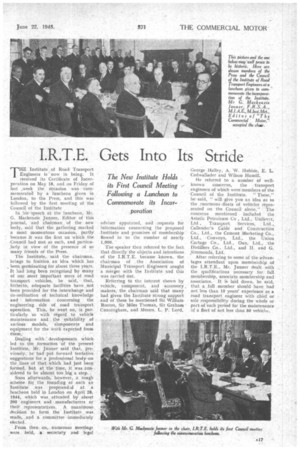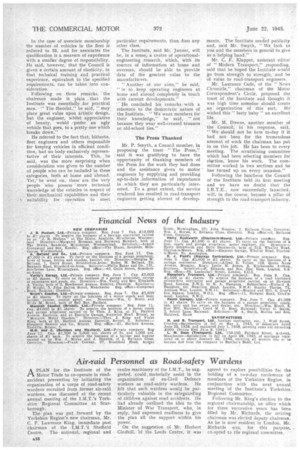I.R.T.E. Gets Into Its Stride
Page 19

Page 20

If you've noticed an error in this article please click here to report it so we can fix it.
The New Institute Holds its First Council Meeting Following a Luncheon to Commemorate its Incor.
poration
THE Institute of Road Transport Engineers is now in being. It received its Certificate of Incorporation on May 18, and on Friday of last .week the occasion was cornmemoratea by a luncheon given in London, to the Press, and this was followed by the first meeting of the Council of the Institute
In his speech at the luncheon, Mr. G. Mackenzie Junner, Editor of this journal, and chairman of the new body, said that the gathering marked a most momentous occasion, partly because it was the first on which the Council had met as such, and particularly in view of the presence of so many friends of the Press.
The Institute, said the chairman, brings to fruition an idea which has been germinating for about three years. It had long been recognized by many of our most important users of road transport vehicles, he said, that, hitherto, adequate facilities have not been provided for the interchange and co-ordination of technical knowledge and information concerning the engineering side of road transport operation. This, he went on, is particularly so with regard to vehicle maintenance and the suitability of various models, cOmponents and equipment for the work expected from them.
Dealing with developments which led to the formation of the present Institute, Mr. Junner said that, previously, he had put forward tentative suggestions for a professional body on the lines of that .which had just been formed, but at the time, it was consided to to be almost too big a step.
Soon afterwards, however, a rough scheme for the founding of such an ,Institute was propound:xi at a luncheon held in London on April 28. 1944, which was attended by about 200 engineers and manufacturers or their representatives. A unanimous deciiion to form the Institute was made, and a committee -immediately elected.
adviser appointed, and requests for information concerning the proposed Institute and promises of membership flowed in to the number of nearly 1,000.
The speaker then referred to the fact that directly the objects and intentions, of the I.R.T,E, became known, the chairman of , the Association of Municipal Transport Engineers sought a merger with the In_stitute and this was carried out.
Referring to the interest shown by vehicle, component, and accessory makers, the chairman said that many had given the Institute strong support and of these he mentioned Sir, Rootes, Sir Miles Thomas, Sir Graham Cunningham, and Messrs_ L. P. Lord,
George Halley, A. W. Hubble, E. L. Cadwallader and Wilson Hamill.
He referred to a number of wellknown concerns, the transport engineers of which were members of the Council of the Institute, " These," be said, " will give you an idea as to the enormous-fleets of vehicles represented on the Council alone," The concerns mentioned included the Asiatic Petroleum Co , Ltd., Unilever, Ltd , Transport Services, Ltd., Callender's Cable and Construction Co., Ltd., the Cement Marketing Co., Ltd., Convoys, Ltd., the Union Cartage Co., Ltd., Oxo, Ltd., the Distillers Co., Ltd., and H. and G. .Simmonds, Ltd.
After referring to some of the advantages attendant upon meMbership of the I.R.T.E., Mr. junner dealt with the qualifications necessary for full membership, associate membership and associates. It is laid down, he said, that a full member should have had not less than 10 years experience as a road transport engineer with chief or sole responsibility during the whole or part of such period for the maintenance of a fleet of not less than 50 vehicles:. In the case of associate membership the number of vehicles in the ,fleet is reduced to 25, and for associates the qualification is a measure of experience with .a smaller degree of responsibility. He said, however, that the Council is given a Certain amount of elasticity, in that technical training and practical experience, equivaleirt to the specified requirements, can be 'taken into consideration.
Following on these remarks, the chairman made it plain that the Institute was essentially for practical men. -" The theorist," he said, " may place great value upon artistic design, but the engineer, whilst appreciative of beauty, woUld prefer an ugly vehicle that goes, to a pretty one which breaks down."
He referred to the fact that, hitherto, fleet engineers and others responsible for keeping vehicles in efficient condi; tion, had no body exclusively representative of their interests. This, he said, was the more surprising when consideration was given to the number of people who can be included in these categories, both at. home and abroad.. Yet,' he Went on, these are the very people who possess • more technical knowledge of the vehicles, in respect. of 'their mechanleal Capabilities and their suitability for operation to meet particular requirements, than does any other class.
The Institute, said Mr. Junner, will be, in a sense, a centre of operationalengineering research, which, with its sources of information at home and overseas, should be able to provide -data of the greatest value to the manufacturers.
" Another of our aims," he said, "is to keep operating engineers at home and abroad completely in touch with current developments."
• He concluded his remarks -with a reference to the democratic nature of the Institute. " We want members for their knOwledge," he said, " not because they wear well-creased trousers or old-school ties."
The Press Thanked
Mr. P. Smyth, a Council member, in proposing the toast " The Press,': said it was gratifying to have the opportunity of thanking members of the Pres•s for the work they had done and the assistance given to motor engineers by supplying and providing up-to-date information of importance in which they are particularly interested. To a great extent, the service rendered has resulted in road-transport engineers getting abreast of develop. meats. The Institute needed publicity and, said -Mr. Smyth, " We look to you and the members in general to, give us. a helping hand."
Mr. C. F. Klapper, assistant editor of "Aodern Transport," _responding, said that he hoped the Institute would go from strength to strength, and be of value to road-transport engineers.
Mr. Laurance Cade, of the " News Chronicle," chairman of tire Motor Correspondent's Circle, proposed the toast of the Institute, and thought it was high time someOne should. create an organization of this ' sort. . He' wished this " lusty baby " an excellent ' life.
Mr: M. Downs, another-member of the Council, in his response, said. " We should not be here to-day if it had not been for the tremendous amount of work the chairman has put in on this job. He has been to every meeting. The scrutinizing committee which had been selecting members for elwtion,know his work. The committee worked in two sections and he hasturned up on every occasion."
Following the luncheon the Council of the Institute held its first meeting arid we have no doubt that the I.R.T.E., now successfully, lauuched, will, in due course, become a pillar of strength to the road-transport industry.




















































